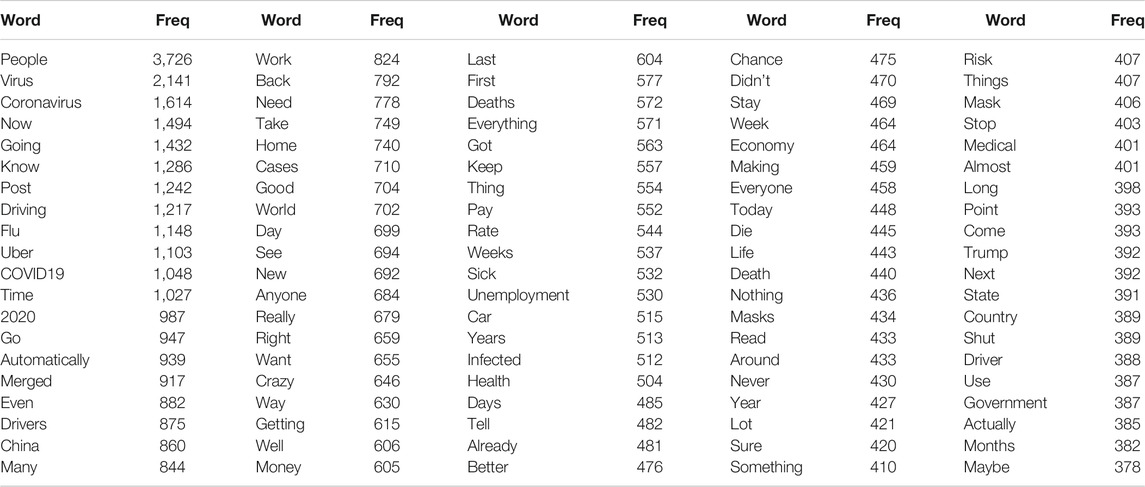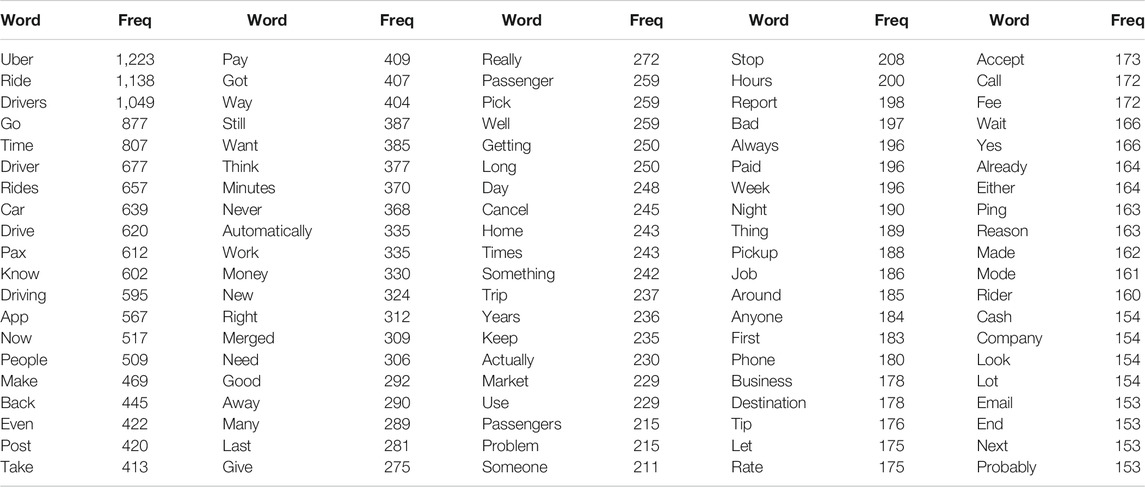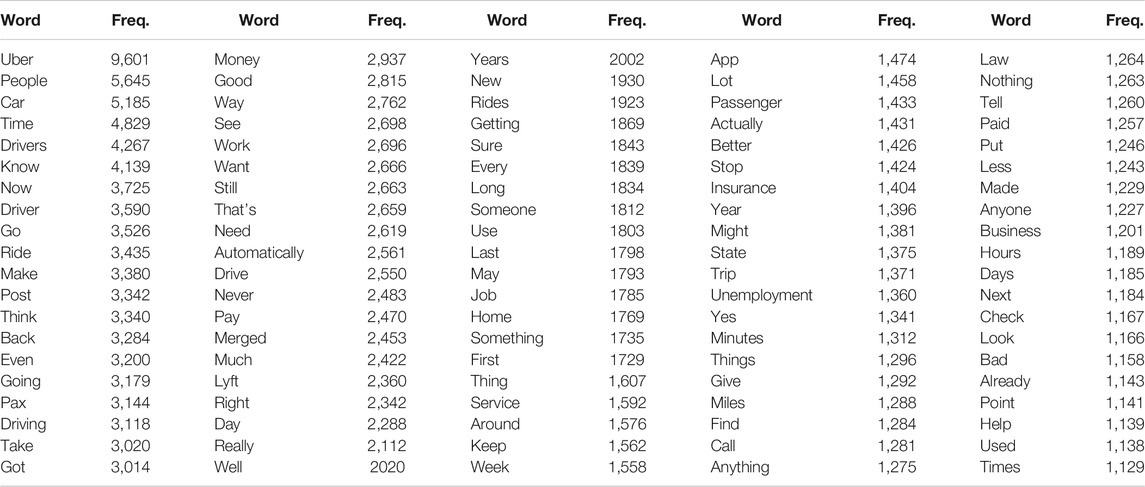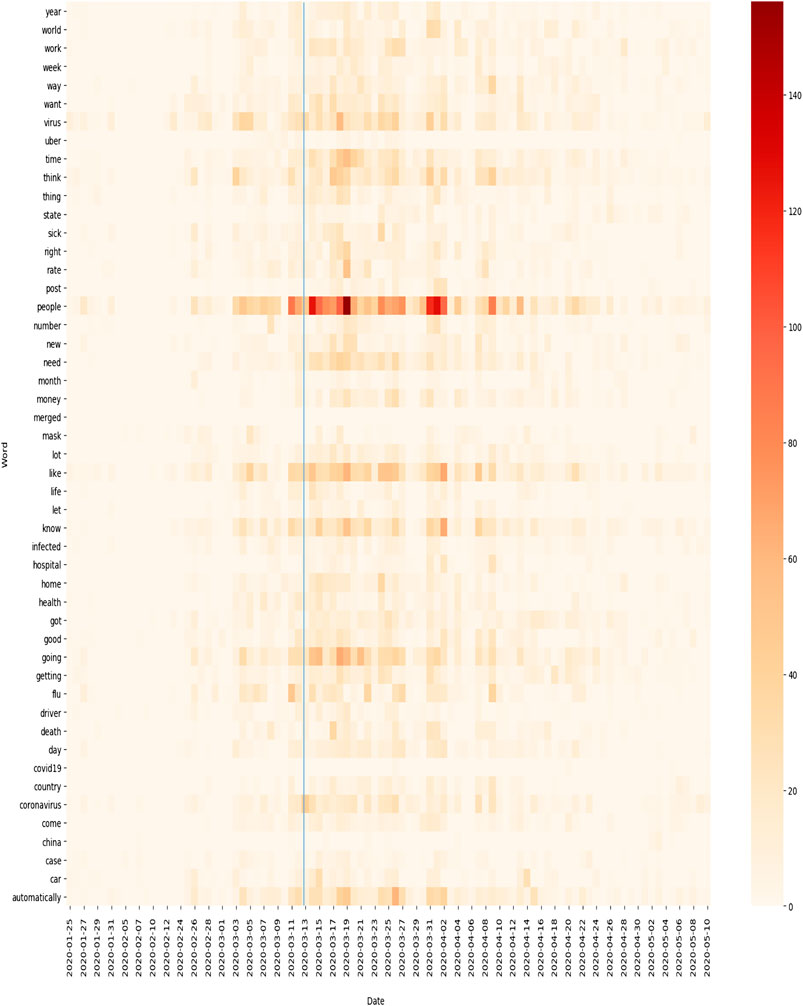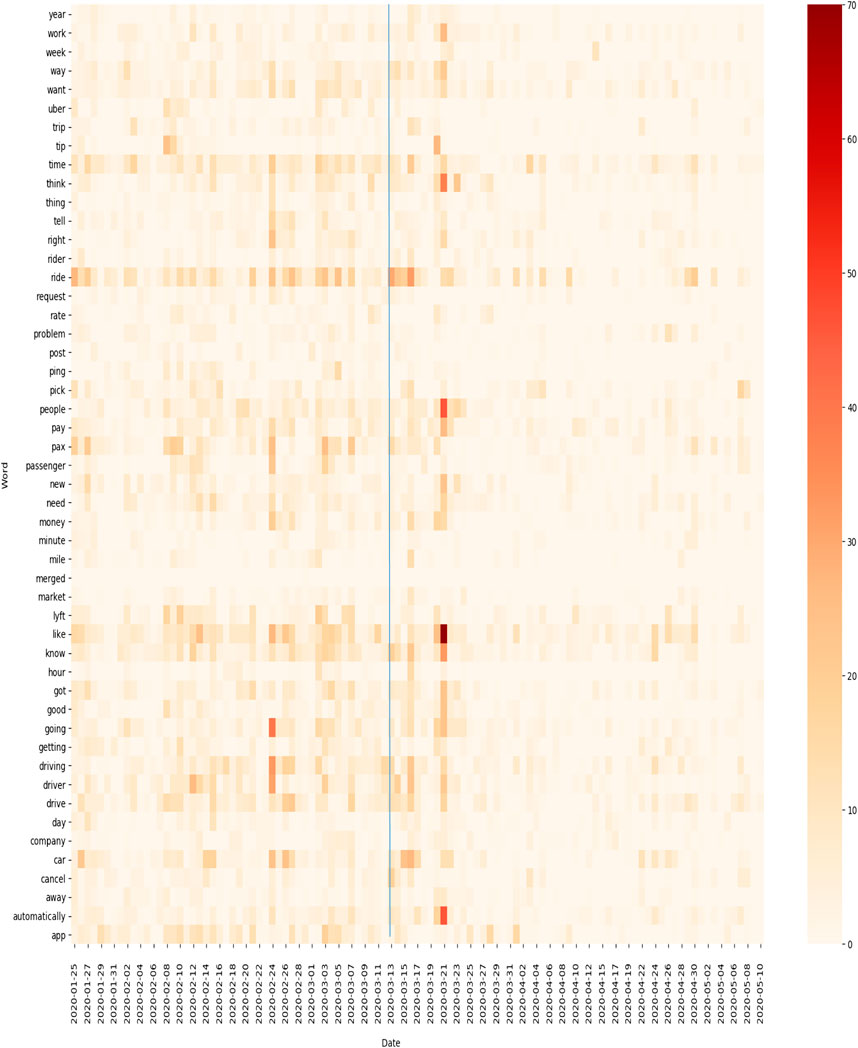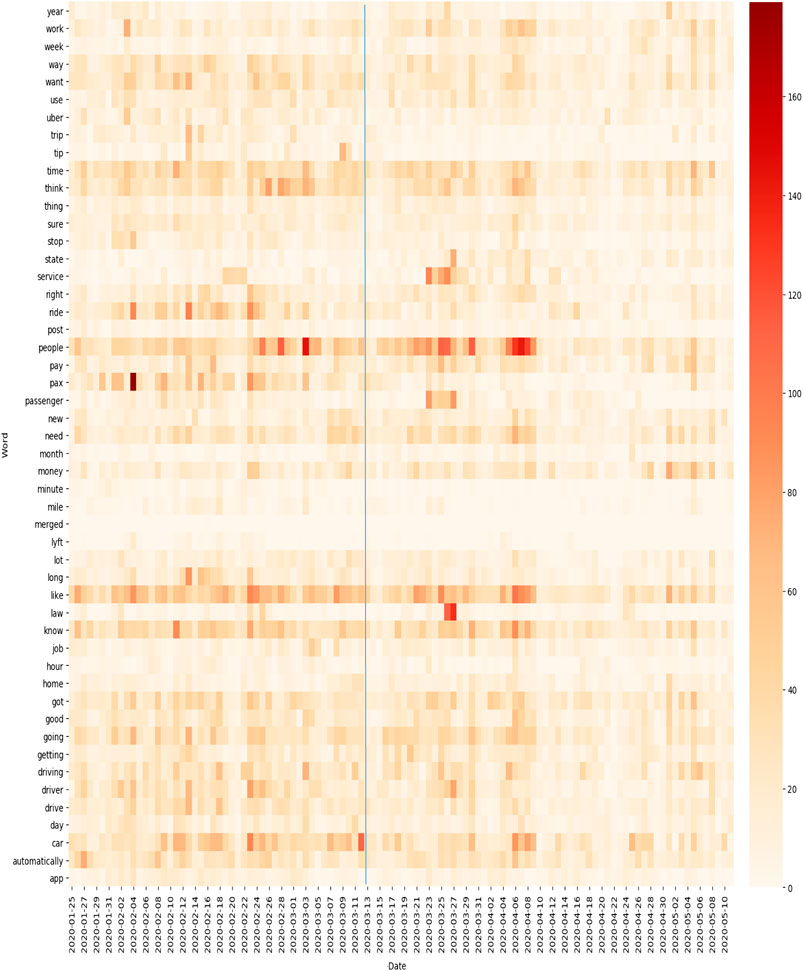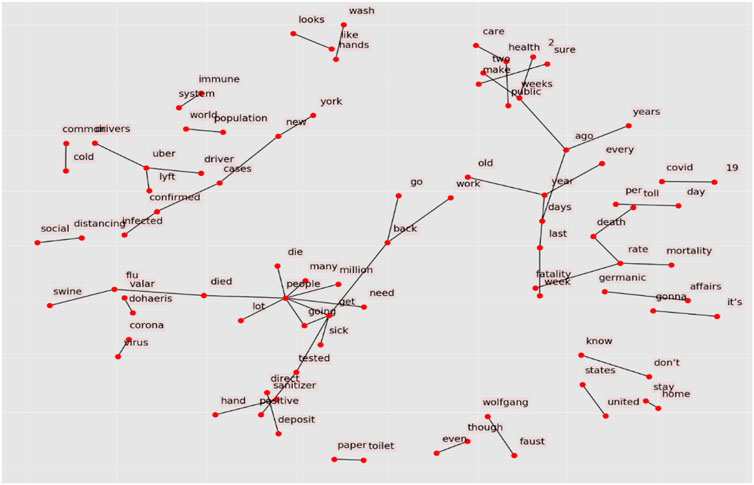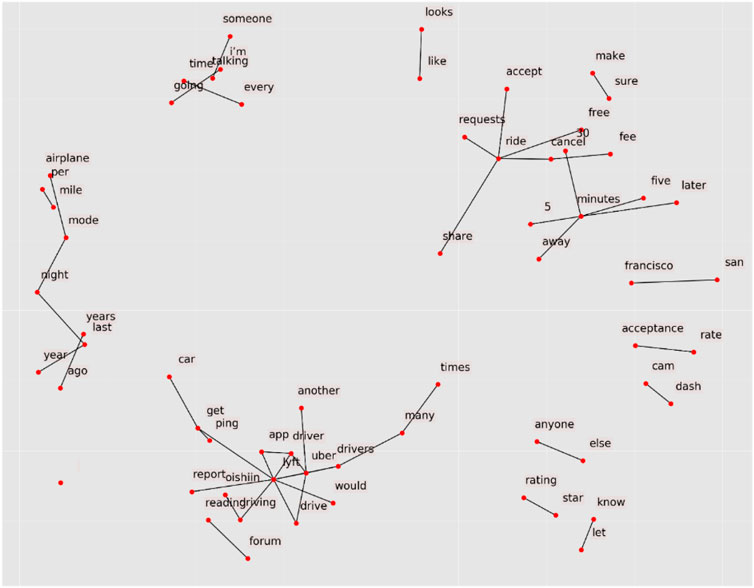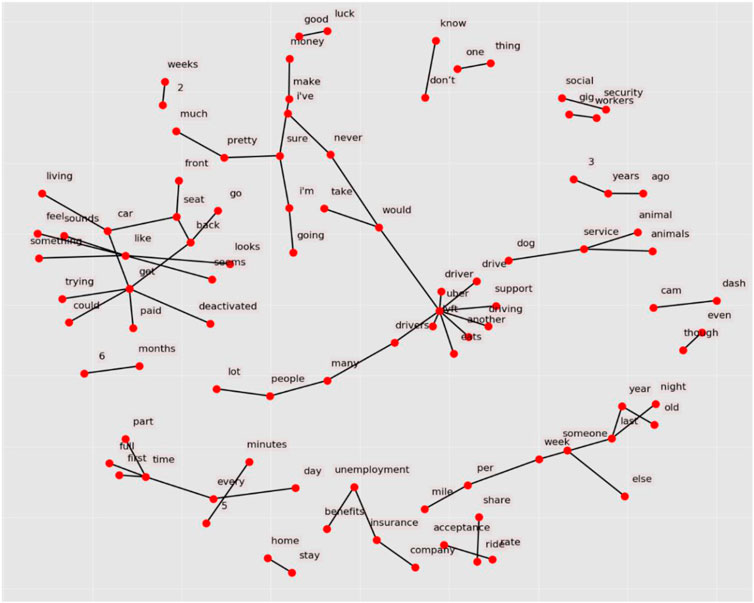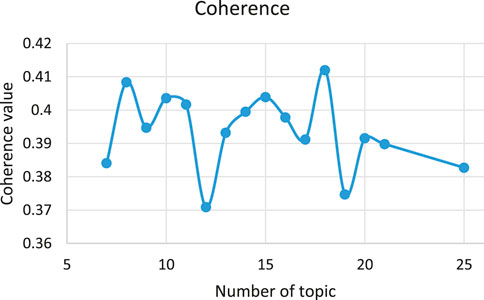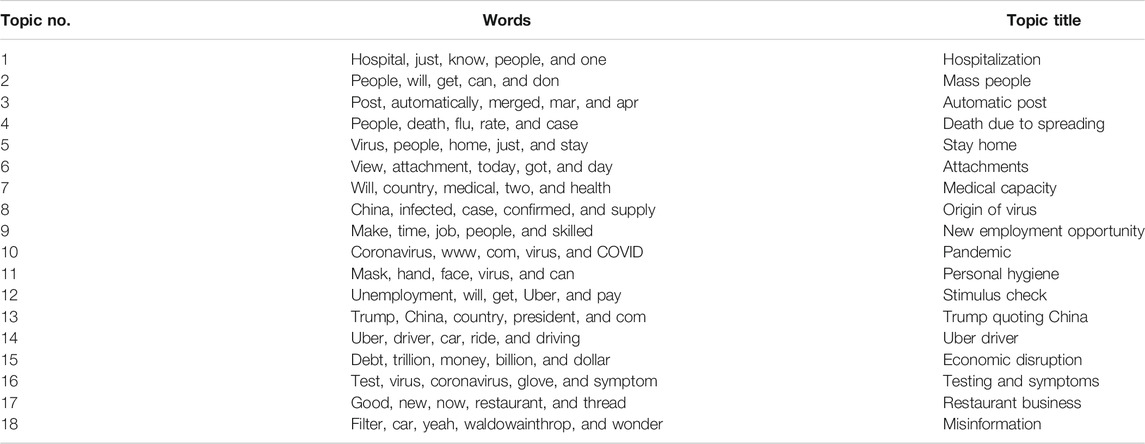- 1 Department of Civil and Environmental Engineering, Florida International University, Miami, FL, United States
- 2 Moss Department of Construction Management, Florida International University, Miami, FL, United States
The outbreak and emergence of the novel coronavirus (COVID-19) pandemic affected every aspect of human activity, especially the transportation sector. Many cities adopted unprecedented lockdown strategies that resulted in significant nonessential mobility restrictions; hence, transportation network companies (TNCs) have experienced major shifts in their operation. Millions of people alone in the USA have filed for unemployment in the early stage of the COVID-19 outbreak, many belonging to self-employed groups such as Uber/Lyft drivers. Due to unprecedented scenarios, both drivers and passengers experienced overwhelming challenges that might elongate the recovery process. The goal of this study is to understand the risk, response, and challenges associated with ridesharing (TNCs, drivers, and passengers) during the COVID-19 pandemic situation. As such, large-scale crowdsourced data were collected from online ridesharing forums (i.e., Uber Drivers) since the emergence of COVID-19 (January 25–May 10, 2020). Word bigrams, word frequency heatmaps, and topic models are among the different natural language processing and text-mining techniques used to preprocess the data and classify risk perception, risk-taking, or risk-averting behaviors associated with ridesharing during a major disease outbreak. Results indicate higher levels of concern about economic disruption, availability of stimulus checks, new employment opportunities, hospitalization, pandemic, personal hygiene, and staying at home. In addition, unprecedented challenges due to unemployment and the risk and uncertainties in the required personal protective actions against spreading the disease due to sharing are among the major interactions. The proposed text-based data analytics of the ridesharing risk communication dynamics during this pandemic will help to identify unobserved factors inadvertently affecting the TNCs as well as the users (drivers and passengers) and identify more efficient strategies and alternatives for the forthcoming “new normal” of the current pandemic and the ones in the future. The study will also guide us toward understanding how efficiently online social interaction outlets can be designed and implemented more effectively during a major crisis and how to leverage such platforms for providing guidelines during emergencies to minimize transmission of disease due to shared travel.
Introduction and Motivation
The emergence and outbreak of the novel coronavirus (COVID-19) affected every aspect of our daily lives. Wuhan, China, was among the first of the cities that went through major lockdown activities (December 2019); however, the disease continued to spread. With time, the COVID-19 turned into a pandemic; hence many cities adopted unprecedented lockdown strategies that resulted in significant nonessential mobility restrictions. As such, to prevent further spreading of the disease, many countries and states have called for the temporal lockdown, practicing physical distancing, restricting nonessential travel and mass gathering, and closing different shops, schools, and offices, among others. However, working from home and online shopping have become more prominent, providing people with new opportunities in terms of income and sharing economy.
The COVID-19 has created uncertainty and great depression, the same magnitude as during the great depression of 1929–1933 and larger than the financial crisis of 2008-2009 (Baker et al., 2020). In 2019, the Chinese national growth was 7.8% surpassing the national average of 6.1%. But with the spreading of viral disease, a lot of workers have evacuated from the city and temporarily halted economic growth. Around 70,000 movie theaters closed down and a lot of airlines declined flights to and from China which is also hampering tourism and business activities. Experts believe that the impact of COVID-19 on a global scale could be huge as Chine contributes approximately 16.3% of the world’s GDP. Bloomberg economists believe that without reaching the peak of infection the full impact of fatal disease cannot be told (Ayittey et al., 2020). Uber being a new form of business has a substantial impact on taxi drivers. Recently taxi services have faced increased competition from digital ride-hailing services such as Uber and the earnings of these taxi drivers have reduced (Berger et al., 2018).
Transportation network companies (TNCs) have also experienced major shifts in the way they operate (Amekudzi-Kennedy et al., 2020). Around 30 million people alone in the USA have filed for unemployment in the early stage of the COVID-19 outbreak, many belonging to self-employed groups such as Uber/Lyft drivers (Neumann, 2020). The sharing economy (such as ridesharing and resource sharing) is no longer the same and will take humongous time and effort to recover fully (Toyama, 2020). Due to unprecedented scenarios, both drivers and passengers experienced overwhelming challenges that might elongate the recovery process. For example, drivers are receiving fewer opportunities to pick up passengers since the pandemic, and such limited options could expose them to life-threatening risks while carrying passengers who are asymptomatic or showing mild symptoms while the availability of personal protective equipment (PPE) is extremely limited (Brown, 2020). Likewise, passengers are also experiencing dilemmas whether or not to use TNC services and looking for options where less sharing is required. Captive riders (i.e., people who do not own a vehicle) are suffering from more adverse consequences compared to any other group. To leverage this unprecedented situation, several agencies have provided guidelines for ridesharing during COVID-19 (CDC, 2020; OSHA, 2020).
The goal of this study is to understand the risk, response, and challenges associated with ridesharing (TNCs, drivers, and passengers) during the COVID-19 situation. In this study, the pandemic-induced occurrences that are affecting the normal day-to-day ridesharing activities are considered as risks, the strategies required to overcome this uncertain situation are deliberated as responses, and the difficulties faced to implement the strategies effectively are defined as challenges. As such, large-scale crowdsourced data were collected from online ridesharing forums (i.e., Uber Drivers) since the emergence of COVID-19 (January 25–May 10, 2020). Crowdsourcing is an act of a company or institution in which functions are performed by employees and a large network of undefined people in the form of an open call (Howe, 2006). The method of building a dataset with the help of a large group of people is called crowdsourced data collection (Bank, 2020). Kraemer et al., 2017, had used crowdsourced data for analyzing nationwide tobacco use (Kraemer et al., 2017). Likewise, the Uber People forum includes public interactions where forum participants share their experiences by posting about their needs, concerns, frustration, and satisfaction, i.e., the overall views on certain topics to which others can react and provide feedback. Such communications have further escalated due to COVID-19. We used several natural language processing techniques to preprocess the data and adopted text-mining approaches to classify risk perception, risk-taking, or risk-averting behaviors associated with ridesharing during a pandemic.
The proposed text-based data analytics of the dynamics in ridesharing risk communication patterns during this pandemic will help to identify unobserved factors inadvertently affecting the TNCs as well as the users (drivers and passengers) and identify more efficient strategies and alternatives for the forthcoming “new normal” of the current pandemic and the ones in the future. The study will also guide us toward understanding how efficiently online social interaction outlets can be designed and implemented more effectively during a major crisis and how to leverage such platforms for providing guidelines during emergencies to minimize transmission of disease due to shared travel. The guideline will also help drivers, passengers, and the people involved with TNCs to understand the specific things to practice (e.g., personal hygiene) and works to be done (e.g., personal protective actions) during an unprecedented situation like the COVID-19 pandemic, which will eventually allow more audience-centric dissemination of ridesharing risk information in real time through emerging social media platforms.
Background and Related Work
Considering sustainable transport networks, there is an increasing activity which is reflected in an expanded range of worldwide efforts to build and quantify sustainability in transportation planning and infrastructure provision, in particular important initiatives in North America. To characterize the emergent thinking on what constitutes transportation sustainability and how to measure it as there is no standard definition for transportation system sustainability, it is largely being defined through impacts of the system on the economy, environment, and society as well as the impacts of the system on the natural environment (Mihyeon Jeon and Amekudzi, 2005). Hence, ridesharing could be a sustainable solution to increase the efficiency of the transportation network by reducing the number of vehicles and their impact on the environment.
In recent literature, researchers have focused on the sharing economy during disasters, particularly shared mobility (Ahmed et al., 2020b). Wong et al. clarified that the sharing economy leverages the vacant aptitude and properties of people by using cellular and Internet-based resources. Mobility and housing sectors are notable examples in this regard (Wong et al., 2018b). Li et al. addressed the productivity of shared mobility providers in emergency situations and highlighted the increase of TNCs such as Uber and DiDi (Li et al., 2018). Shaheen et al. defined shared mobility as the shared use of motor vehicles or other low-speed modes of transport that enables users to obtain the necessary short-term access to transport (Shaheen et al., 2017). Wong et al. suggested that the sharing economy is relevant to transport and resource shelter in crises, as public authorities still lack adequate resources during disaster and shelter for all residents in emergency situations (Wong and Shaheen, 2019).
The shared vehicles use high occupancy vehicle (HOV) lanes (if available) which can reduce the travel cost of riders and also lower the emission rate which ensures a better environment. Song et al. developed an evolving network design model that simultaneously optimizes HOV and high occupancy toll (HOT) lanes and the traffic congestion mitigation rate. The social and environmental advantages of this demand management approach are important (Song et al., 2015). Another study emphasized a closed network queue model of ridesharing systems, Didi, Lyft, and Uber, for example. In order to maximize system-wide services, e.g., the availability of empty cars when a passenger arrives, the emphasis was on empty car routing, a process through which car flow in the network can be monitored (Braverman et al., 2019). Moody et al. determined the cogency, dependability, and invariance of the measurement between social class discrimination and the rider-to-rider race. This measure is then integrated into three model structures, which link between discriminatory attitudes of rider-to-rider and four different aspects of rides (Moody et al., 2019).
Social media is emerging as an efficient information dissemination platform during emergency situations (Ukkusuri et al., 2014; Roy et al., 2020a; Sadri et al., 2020) such as hurricanes and pandemics (Ahmed et al., 2020a). Effective crisis communication plays a salient role in social media to better manage the disaster. Traditional media is primarily intended for one-way communication whereas social media allows two-way communication; hence, social media platforms are exclusively different (Brown, 2015). Sadri et al. explained the critical role of social media during a crisis by facilitating communication and information dissemination to both evacuees and nonevacuees during Hurricane Sandy (Sadri et al., 2017a; Sadri et al., 2018; Roy et al., 2020b). Pender et al. explored the role of social media to manage inadvertent transit network disruptions during postdisasters which indicated that receiving real-time information through social media allowed people to take effective decisions in terms of traveling through alternative routes (Pender et al., 2014). ICTs (Information and Communication Technologies) are important to transportation systems in providing travel information, preparation in planning, transport modes sharing, operating at distances, comparing transport costs, payment, changes in security, and safety as well as communicating travel patterns (Gössling, 2018).
Data Description
In this study, large-scale crowdsourced data were collected from online ridesharing forums named Uber Drivers Forum since the emergence of COVID-19 (January 25–May 10, 2020). Such forums include public interactions where forum participants share their experiences by posting about their needs, concerns, frustrations, and satisfaction, i.e., the overall views on certain topics to which others can react and provide feedback. Uber drivers can switch to Lyft looking for passengers. Although this platform name is “Uber Drivers Forum,” the forum also has a section where Lyft drivers can interact using the Lyft subforum. Such communications have further escalated due to COVID-19. More specifically, the data were collected from three different subforums named “Advice,” “Corona,” and “Lyft.” The data extraction was done using the Google Chrome extension web scrapper (WebScrapper, 2020). The web scrapper was designed and implemented as such all discussions from these subforums can be monitored and retrieved. This included all the comments from all of the associated discussion pages in the text data format along with time information. As such, the data included 6,464 texts from the Corona forum, 3,175 texts from the Lyft forum, and 20,134 texts from the Uber Advice forum.
Some examples include the following: 1) What if coronavirus ends up being similar to swine flu? It's estimated that swine flu killed over 12,000 people (March 26, 2020). 2) If you really want to get totally Frustrated I recommend you apply for unemployment. It's a fate worse than waterboarding (April 13, 2020). 3) If I don’t get unemployment or the PPP loan I’ll be going back to work soon. So I’ve been getting ready (April 19, 2020). 4) This whole thing is one big scam! The people who really run this world like the Rothschilds and Vanderbilts and the ones who run the media are causing this panic so they can destroy the economy (April 21, 2020). The data consisted of emoticon, punctuation, prepositions, pronouns, and repeated words as view attachment, click to expand which was cleaned for further analysis. The authors used several natural language processing techniques to preprocess the data and adopted text-mining approaches to classify risk perception, risk-taking, or risk-averting behaviors associated with ridesharing during a pandemic.
Methodology
In this section, the methodologies adopted in generating the data analytics and infographics are explained briefly.
Most Frequent Words and Temporal Heatmaps of Word Frequency
Count the number of words that had been used in the forum and sort the words based on their frequency for finding the most frequent words which are popularly being used in natural language processing. Again, temporal or time series is used frequently to understand how internal patterns (trends or time series analysis) have changed over time, for representing the corelation between the most frequently used words in relevant Uber People forum and the day of post origination. It illustrates the daily variation of the most frequent words used in the forum. The temporal analysis gives an insight into the variation of popular emerging trends as well as the trends being obsolete over time.
Word Bigram Analysis
Word bigram is one of the concepts of natural language processing where it searches for the probability of a pair of words occurring next in a sequence of words. It can help chunking pairs of words together to form single entities and also predict the next word used in the forum. The word sequence w 1 … w N is separated from the sequence of text observations x 1 … x T for which the posterior probability Pr (w 1 … w N |x 1 … x T ) achieves its maximum, which can be written as
where Pr (x 1 … x T |w 1 … w N ) is the conditional probability, given the word sequence w 1 … w N . Using the conditional probabilities, we obtain the decomposition as
We can partition the vocabulary of size W in number G of word classes. The category mapping can be written as G: w → G w , mapping each word w of the vocabulary to its word class G w . For the word bigram (v,w), we use (G v , G w ) for denoting the corresponding class bigram. For maximum likelihood estimation, the equation could be written as
F
bi
denotes bigram maximum likelihood; W denotes vocabulary size; u, v, w, and x denote words in a running text; N denotes training corpus size;
Topic Model
The framework of the topic model is a mathematical model for exploring the empirical themes or topics that exist in a set of text-based data in natural language processing. This was first explained by David Blei based on the simplest topic model named Latent Dirichlet Allocation (LDA). The instinct behind LDA is that the set of texts reveals numerous topics. A topic model is used for the discovery of secret semantic structures in text bodies, which is a recurrent data mining method. Clusters of similar terms are the themes or topics created by topic modeling technology. A topic model captures the instinct of LDA in a mathematical system that allows a collection of documents to be checked by defining possible subjects with the balancing of the subjects of each document, which is based on word statistics in each topic. This model can help us to organize and provide insights from a vast collection of disorganized texts (Blei, 2012).
Blei et al. applied the generative model to Dirichlet priors and used variational Bayes to learn θ and φ by maximizing the likelihood of the collection of terms (Blei et al., 2003). Griffiths and Steyvers suggested the use of collapsed sampling of Gibbs to allow an approximate conclusion by considering the posterior distribution over word assignments to subjects or topics P(z|w) (Griffiths and Steyvers, 2004). Summarizing the derivation steps, the update function for a new topic assignment of a word in the sampling process is expressed in the following:
Here, n (t, w) is the number of assignments of word w in topic t, and n (d, t) is the number of assignments of topic t in document d; all counts exclude the current assignment z. The descriptions of different variables are listed below: T = count of topics; W = count of distinctive words; D = count of documents; N = count of tokens; θ = D × T of probabilities; topic distribution in documents; φ = T × W of probabilities; word distribution in topics; α = D × T of α priors; Dirichlet prior for θ; β = T × W of β priors; Dirichlet prior for φ; w = N-Vector of word identity w; words in documents; z = N-Vector of topic assignment z; topic assignment of words (Lau et al., 2012).
Results and Discussion of Findings
The collected data have been processed and filtered for analyzing the most frequent words, word generation over time heatmap, topic modeling, and bigram model. The results and discussions are presented in different subsections following the three different forums we analyzed: 1) Corona forum, 2) Lyft forum, and 3) Uber Advice forum.
Word Frequencies in Corona Forum
The 100 most frequent words from the Corona forum illustrate concern about the global pandemic listed in Table 1, where forum participants put more emphasis on the spreading of coronavirus and the death tolls due to the pandemic through the words like viruses, people, flu, China, sick, new, cases, lot, and death, among others. The Corona forum started on 25 January when forum participants became more concerned about the coronavirus; hence, such discussions increased. We quoted an original post from this forum: “I was driving a nice university student from China today. We had a great conversation about the Flu, and as I dropped her off I learned she was from Wuhan. This was a bit awkward, and I resolved to remain sensitive to Chinese pax, especially to those that may have family in Wuhan (January 25, 2020).” Also, forum participants were worried about their work which can be seen from words such as work, economy, shut, unemployment, money, need, and want, among others. We quoted an original post from this forum: “Well when people start to run out of money and food in two to three weeks. As the unemployment servers have crashed. And looting starting to happen in London and France, what will you do? (March 19, 2020).” Apart from that, health-related concerns were also prominent which can be seen from words like medical, government, die, infected, and anyone, among others. Another related post from this forum is “We must also understand that this situation is akin to war when it comes to being able to trust what officials say. The old adage “Truth is the first casualty of war” applies here. Take anything the government admits to (China, USA, or whoever), and multiply by 10. Or 100 (February 27, 2020).” Finally, the importance of wearing a mask and the role of the government to handle the pandemic got also noticed in the conversations of this forum.
Word Frequencies in Lyft Forum
The 100 most frequent words were generated based on discussions in the Lyft forum; however, the word Uber revealed the highest prominence followed by words like ride and drivers (Table 2). In addition, we see pax (meaning passengers), people, and passengers, among others. It shows the concern about the passengers or customers of TNCs who are key contributors to the ridesharing economy. During this corona crisis, forum participants also talked about being safe from passengers. For example, this original post can add more to that “Neither Lyft nor Uber is discussing the real issue here which is informing passengers to travel with masks when ordering rideshare service, I am sure most people have masks by now (March 02, 2020).” This shows prior concerns about the passengers long before steps taken by authorities and the day when the national emergency was declared, i.e., March 13, 2020. Likewise, concerns about the drivers and rides through words like driver, drive, rides, and rider were found in the most frequent words. We quoted an original post from this forum: “rarely get tips, long pick-ups for short trips, seem to guarantee myself $5/hour if I take a Lyft trip because between the pick-up time, waiting for the passenger time (February 18, 2020).” Forum participants also discussed the unemployment and adverse effects on business continuity.
Word Frequencies in Uber Advice Forum
The top 100 most frequent words of Uber Advice forum shows similarity with the Lyft forum (Table 3). Discussion related to the virus, coronavirus, flu, covid19, case, deaths, world, sick, infected, mask, and law, among others, were found in the forum. We quoted an original post from Uber Advice forum: “With all the recent media coverage of covid-19, I decided to play it safe and start wearing a surgical face mask when I drive. I'm stuck in an enclosed space all day with all sorts of pax coming in” (Feb 17, 2020). The concern about unemployment was found in their conversation through words like unemployment, check, insurance, pay, job, find, and money. We quoted an original post from this forum: “For all the drivers who are happy sitting at home and not driving while collecting unemployment, what’s going to happen as the stay-at-home orders and social distancing orders get lifted? (May 10, 2020).” The state emergency for COVID 19 number of rides reduced and a lot of drivers filed for unemployment. Besides, forum participants were also concerned about their insurances (health and car) in the pandemic situation. For better understanding, the temporal heatmap over time is generated.
Temporal Heat Map of Corona Forum
The most frequent word over the time of Corona forum, the period of March 3 to April24, seems to have more frequency of post and frequent words. The forum started on January 25 and took a bit of time to be popular that is why we can observe the first few days having less post on the left side of Figure 1. The temporal heatmap also showed most discussion about people used in the whole span of study. The discussion about mask showed more frequency at the beginning of March and the discussion reduced regarding personal hygiene. However, after March 13, increased use of the word coronavirus shows importance toward state emergency as shown in Figure 1. The drivers also discussed their work-related topics like work, time, money, getting, ride, car, rate, way, Uber, need, and other related words. It is also found that health concern was there and the following keywords over time have been seen hospital, health, and life. It can be observed that forum participants were talking about the need from late February which could denote the need for more rides, employment, policy, money, and other related words because forum participants started panicking at this stage and ridesharing started to decrease.
Temporal Heatmap of Lyft Forum
The temporal heatmap of the Lyft forum shows that the distribution of the most frequent words is generated from earlier days of the corona outbreak and after March 23, the discussion reduced on this forum (Figure 2). An intensified discussion related to ride has been seen after the state emergency (March 13). In addition, the word cancel seems to be a popular topic during this time which shows the concern of the drivers of being unemployed. The heatmap of the Lyft forum also shows tips being discussed at the beginning of February and then after a long break from the end of March, the frequency of using tip reappeared.
Temporal Heatmap of Uber Advice Forum
The temporal heatmap of the most frequent words of Corona Advice forum shows discussion about the ride which was more popular before March and later on the discussion reduced (Figure 3). Likewise, it is interesting to see that around the 23rd to 27th of every month, forum participants talk about law a lot and for the rest of the month, the topic is not discussed that much. The forum participants of the Uber Advice forum have reduced talking about tips after March 17 and it could be the reason for the economic impact on every aspect of people. Riders were more concerned about their trips than tips, which may reflect why people reduced using Uber.
The frequent word may not show the full picture of the topic being discussed. The pair of words demonstrates a better understanding of the topic being discussed in the forum. We have added a bigram analysis of these three forums.
Word Bigram Analysis of Corona Forum
The bigrams generated from the discussion of the Corona forum indicated that people held the most central position in the word bigram network (Figure 4). However, this coexisted with words like many, die, lot, going, get, and need, among others. Likewise, we can see that forum participants in Corona forum were talking about COVID 19, confirmed cases, confirmed infected, common cold, swine flu, hand sanitizer, positive tested, get sick, stay home which represents COVID 19 related infection, protection by maintaining personal hygiene, and awareness to stay at home. Again, forum participants were also talking about death rate, mortality rate, public health, health care, toilet paper, social distancing, immune system, New York, wash hands, coronavirus, and two weeks, among others. With the corona crisis, people started panic buying too and a lot of products hand sanitizer and toilet paper which were the most common items in panic buying also came into the discussion in the Corona forum. New York had faced furious spreading of corona disease compared to other states and that is why this location is also found in the forum discussion.
Word Bigram Analysis of Lyft Forum
The bigrams generated from the discussion of the Lyft forum indicated that Lyft held the most central position in the word bigram network (Figure 5). However, this coexisted with words like app, Uber, and driver, among others. Likewise, the word ride was another highly central word that coappeared with words like accept, cancel, requests, and share, indicating a high degree of concern about the challenges in requesting and canceling rides through Lyft. Other clusters of words indicated discussions on estimated arrival time (ETA), ratings of Lyft performance, dashboard camera, and locations such as San Francisco.
Word Bigram Analysis of Uber Advice Forum
Uber held the most central position in word bigram analysis of the Uber Advice forum (Figure 6). However, this word is found with the pair of the driver, drivers, support, Lyft, another, and driving which can be interpreted as Uber driver, Uber drivers, Uber Lyft, another Uber, Uber driving, and so on. Likewise, unemployment benefits, unemployment insurance, and insurance company show the discussion about seeking opportunities during crisis moments and also show that people were trying to play safe during COVID-19 by filing unemployment so that they can have at least some benefits from authorities. The forum participants of the Uber Advice forum were also talking about their job status whether their job is part-time or full-time. Again, these pair of words such as get paid, get car, could get, get deactivated, get back, back seat, car seat, and front seat illustrate participants ride experience. Similar to the Lyft forum, the dashboard camera is also found in the discussion of the Uber Advice.
The set of words used in the forum can also be found using topic model analysis. We have analyzed the Corona forum for topic modeling. The topic model is a statistical model to identify the abstract topics in a text document (Ahmed et al., 2020c).
We have analyzed the post from January 25 to May 10 for the different number of topics and found that 18 topics have the highest coherence value as shown in Figure 7. That is why we selected 18 topics for topic model analysis.
In Table 4, we have listed the interaction patterns from the topic model analysis. From topic 1, the rate of hospitalization is observed which is very high in the US. In topic 4, the set of words (people, death, flu, rate, and cases) is a clear discussion about the spreading of corona disease as well as deaths. Discussion about people getting flu symptoms, increasing death rate, flu cases, and death cases is also found in the forum. Stay home order is another discussion (topic 5) from the following word set virus, people, home, just, and stay where people were told to stay at home to reduce the spreading of the virus. With the increment of unemployment, people are also thinking about employment creation (topic 9) so that skilled and immune people can have jobs and utilize their time on economic development.
Due to COVID19, forum participants are more concerned about personal hygiene (topic 11) which can reduce the spreading of the virus. It is recommended to wash hands, not to touch the face, and to wear a mask so that the virus cannot spread from one person to another. Likewise, the set of words mask, hand, face, virus, and can is taken as personal hygiene. In topic 12, people are talking about unemployment, will get, Uber, and pay. This set of words may have appeared for a stimulus check. As the US government has assigned stimulus checks for the people from the emergency fund, Uber drivers may discuss the chance of getting payment and filing for unemployment. Another topic discussed that Donald Trump was quoting about China (topic 13). In recent times, we have seen President Trump mentioning China as the origin of the virus (topic 8) as well as the pandemic.
Topic 15 emphasized economic collapse from the set of words debt, trillion, money, billion, and dollar. As every aspect of life is being affected by the pandemic, the economy is also falling apart. Billions of dollars are being lost continuously due to corona disease. Again, medical capacity (topic 7) and COVID-19 symptoms and testing (topic 16) are also being discussed in the forum. With the exponential increment of the number of cases in the United States, hospitals have been oversaturated with patients with corona symptoms and the government is trying to increase the capacity of the hospital and medical facilities to fight against the corona disease.
Due to the pandemic, small business owners are the most affected and specifically the restaurant businesses (topic 17). In the forum, people were focusing to help these restaurants as much as they can. In the last topic, we found a profile in the forum named waldowainthrop who posted about the misinformation spreading during the pandemic (topic 18). A false number of cases and deaths, misguidance about wearing masks, and an ambiguous statement about the life span of the virus on different surfaces were the main discussions from this profile.
Limitation of the Study
The Uber Drivers Forum mostly consists of ridesharing drivers’ posts related to various issues. But there is no prior authentication required for using this forum. Anyone can post, share, and react without being the actual ridesharing user. Especially, the forum insists user not to use their real name for registering. The dataset used and analyzed for this study may have such posts that may not be from ridesharing users. We assumed that such users are very limited or negligible. The datasets also consist of the driver who is spending their time in this forum either reacting or posting but a lot of drivers may not use this forum or post being busy on their works. The forum post may reflect idle drivers' thoughts, opinions, and other activities and may not reflect the busy drivers’ activities who did not spend time on such forums. However, the timespan we considered in this analysis also consists of less demand for ridesharing and thus most of the drivers fall almost in the same category based on their work pressure.
Conclusion
The emergence and outbreak of the novel coronavirus (COVID-19) affected every aspect of our daily lives. TNCs have also experienced major shifts in the way they operate. With time, the COVID-19 turned into a pandemic; hence, many cities adopted unprecedented lockdown strategies that resulted in significant nonessential mobility restrictions. Around 30 million people alone in the USA have filed for unemployment in the early stage of the COVID-19 outbreak, many belonging to self-employed groups such as Uber/Lyft drivers. The sharing economy (such as ridesharing and resource sharing) is no longer the same and will take humongous time and effort to fully recover. Due to unprecedented scenarios, both drivers and passengers experienced overwhelming challenges that might elongate the recovery process.
The goal of this study is to understand the risk, response, and challenges associated with ridesharing (TNCs, drivers, and passengers) during the COVID-19 pandemic situation. As such, large-scale crowdsourced data were collected from online ridesharing forums (i.e., Uber Drivers) since the emergence of COVID-19 (January 25–May 10, 2020). We used several natural language processing techniques to preprocess the data and adopted text-mining approaches to classify risk perception, risk-taking, or risk-averting behaviors associated with ridesharing during a pandemic. Few interesting results are listed as follows:
• Crisis communication before and after state emergency for COVID-19 shows intensive discussion on global pandemic and concern about unemployment.
• Out of frustration, forum participants indicated corona to be a hoax and blamed the media and others for misreporting it.
• Participants also discussed possible unemployment scenarios and the adverse effects on business continuity due to pandemic.
• Interactions on tipping drivers became less prominent after the declaration of a national emergency, which is indicative of less priority and concern about such activities.
• Awareness of actions required for reducing the risk by the minimal spreading of viruses such as wearing masks and personal sanitization was among the prevalent forum discussions. However, there was no evidence that indicates any concern about enforcing such actions.
• Unemployment insurance and benefits were also found to have appeared in the discussions among the forum participants.
• Participants also discussed their experiences of resource constraints such as hand sanitizer and toilet papers.
• Economic disruption, stimulus check, unemployment, employment opportunity, and staying at home were among the emergent topics discussed by the forum participants. Such topics contribute to the adverse consequences of shared mobility due to a pandemic.
The proposed text-based data analytics of dynamics of the ridesharing risk communication patterns during this pandemic will help to identify unobserved factors inadvertently affecting the TNCs as well as the users (drivers and passengers). It will also help to identify more efficient strategies and alternatives for being accustomed to the forthcoming “new normal” of the current pandemic and the ones in the future. The insights of this study can be helpful to agencies and practitioners to leverage social sharing platforms for more efficient information dissemination to drivers and passengers. In addition, this can support heightened risk perception for minimal transmission of disease due to shared travel to identify more efficient strategies and alternatives for the forthcoming “new normal” of the current pandemic and the ones in the future. However, the crowdsourced data used in this study had limited location information that prevented capturing the spatial variations of such online interactions.
Data Availability Statement
The raw data supporting the conclusion of this article will be made available by the authors upon request with restrictions.
Author Contributions
The authors confirm that all authors contributed to the paper as follows: study conception and design; data collection; analysis and interpretation of results; and draft manuscript preparation. All authors reviewed the results and approved the final version of the manuscript.
Funding
The authors thank the National Science Foundation for the Rapid Response Research grant, IIS-2027360,for supporting the research presented in this paper. However, the authors are solely responsible for the findings presented in this study.
Conflict of Interest
The authors declare that the research was conducted in the absence of any commercial or financial relationships that could be construed as a potential conflict of interest.
Acknowledgments
The authors thank the National Science Foundation for the Rapid Response Research grant, IIS-2027360, supporting the research presented in this paper. However, the authors are solely responsible for the findings presented in this study.
References
Ahmed, M. A., Sadri, A. M., and Amini, M. H. (2020a). Data-driven inferences of agency-level risk and response communication on COVID-19 through social media based interactions. Available at: https://arxiv.org/abs/2008.03866 (Accessed 10 August 2020).
Ahmed, M. A., Sadri, A. M., and Hadi, M. (2020b). “The role of social networks and day-to-day sharing activity on hurricane evacuation decision consistency and shared evacuation capacity,” in Proceedings of the 99th annual meeting of transportation research board. Washington, DC, USA, January 10, 2020.
Ahmed, M. A., Sadri, A. M., Pradhananga, P., Elzomor, M., and Pradhananga, N. (2020c). Social media communication patterns of construction industry in major disasters. Construction Research Congress Proceedings, Tempe, Arizona, March 8–10, 2020. doi:10.1061/9780784482865.072
Amekudzi-Kennedy, A., Labi, S., Woodall, B., Chester, M., and Singh, P. (2020). Reflections on pandemics, Civil infrastructure and sustainable development: five lessons from COVID-19 through the lens of transportation.
Ayittey, F. K., Ayittey, M. K., Chiwero, N. B., Kamasah, J. S., and Dzuvor, C. (2020). Economic impacts of Wuhan 2019-nCoV on China and the world. J. Med. Virol. 92 (5), 473–475. doi:10.1002/jmv.25706
Baker, S. R., Bloom, N., Davis, S. J., and Terry, S. J. (2020). Covid-induced economic uncertainty. Cambridge, MA, USA: National Bureau of Economic Research.
Bank, T. W. (2020). Crowd-sourced data [Online], Available [Accessed]: https://dimewiki.worldbank.org/wiki/Crowd-sourced_Data (Accessed April 12, 2019).
Berger, T., Chen, C., and Frey, C. B. (2018). Drivers of disruption? Estimating the uber effect. Eur. Econ. Rev. 110, 197–210. doi:10.1016/j.euroecorev.2018.05.006
Blei, D. M., Ng, A. Y., and Jordan, M. I. (2003). Latent dirichlet allocation. J. Mach. Learn. Res. 3 (2003), 993–1022.
Blei, D. M. (2012). Probabilistic topic models. Commun. ACM. 55 (4), 77–84. doi:10.1145/2133806.21338210.1145/2133806.2133826
Braverman, A., Dai, J. G., Liu, X., and Ying, L. (2019). Empty-car routing in ridesharing systems. Oper. Res. 67 (5), 1437–1452. doi:10.1287/opre.2018.1822
Brown, D. (2020). No mask. No ride’: Uber will require drivers and passengers to wear face masks indefinitely [Online]. Available at: [Accessed] https://www.usatoday.com/story/money/2020/07/01/uber-require-face-masks-drivers-and-passengers-indefinitely/5354164002/ (Accessed July 1, 2020).
Brown, J. (2015). Is social media the key to effective communication during campus emergencies. Retrieved from Govtech: http://www.govtech.com/education/Is-Social-Media-the-Key-to-Effective-Communication-During-Campus-Emergencies (Accessed February 20, 2015).
CDC, (2020). What rideshare, taxi, limo, and other passenger drivers-for-hire need to know about COVID-19. [Online]: Available:[Accessed] https://www.cdc.gov/coronavirus/2019-ncov/community/organizations/rideshare-drivers-for-hire.html (Accessed Jan 30, 2021).
Gössling, S. (2018). ICT and transport behavior: a conceptual review. International journal of sustainable transportation. 12 (3), 153–164. doi:10.1080/15568318.2017.1338318
Griffiths, T. L., and Steyvers, M. (2004). Finding scientific topics. Proc. Natl. Acad. Sci. U.S.A. 101 (Suppl 1), 5228–5235. doi:10.1073/pnas.0307752101
Kraemer, J. D., Strasser, A. A., Lindblom, E. N., Niaura, R. S., and Mays, D. (2017). Crowdsourced data collection for public health: a comparison with nationally representative, population tobacco use data. Prev. Med. 102, 93–99. doi:10.1016/j.ypmed.2017.07.006
Lau, J. H., Collier, N., and Baldwin, T. (2012). “On-line trend analysis with topic models:# twitter trends detection topic model online,” in Proceedings of the COLING, Mumbai, India, December 2012, 1519–1534.
Li, M., Xu, J., Liu, X., Sun, C., and Duan, Z. (2018). Use of shared-mobility services to accomplish emergency evacuation in urban areas via reduction in intermediate trips-case study in xi'an, China. Sustainability. 10, 4862. doi:10.3390/su10124862
Martin, S., Liermann, J., and Ney, H. (1998). Algorithms for bigram and trigram word clustering. Speech Communication. 24 (1), 19–37. doi:10.1016/s0167-6393(97)00062-9
Mihyeon Jeon, C., and Amekudzi, A. (2005). Addressing sustainability in transportation systems: definitions, indicators, and metrics. J. Infrastucture Sys. 11 (1), 31–50. doi:10.1061/(asce)1076-0342(2005)11:1(31)
Moody, J., Middleton, S., and Zhao, J. (2019). Rider-to-rider discriminatory attitudes and ridesharing behavior. Transport. Res. F Traffic Psychol. Behav. 62, 258–273. doi:10.1016/j.trf.2019.01.003
OSHA, (2020). COVID-19 guidance for rideshare, taxi, and car service workers [Online]. Available: [Accessed] https://www.osha.gov/Publications/OSHA4021.pdf (Accessed September 15, 2020).
Pender, B., Currie, G., Delbosc, A., and Shiwakoti, N. (2014). Social media use during unplanned transit network disruptions: a review of literature. Transport Rev. 34 (4), 501–521. doi:10.1080/01441647.2014.915442
Roy, K. C., Ahmed, M. A., Hasan, S., and Sadri, A. M. (2020a). “Dynamics of crisis communications in social media: spatio-temporal and text-based comparative analyses of twitter data from hurricanes irma and michael,” in Proceedings of the international conference on information systems for crisis response and management (ISCRAM), València, Spain, May 19–22, 2020.
Roy, K. C., Hasan, S., Sadri, A. M., and Cebrian, M. (2020b). Understanding the efficiency of social media based crisis communication during hurricane Sandy. Int. J. Inf. Manag. 52, 102060. doi:10.1016/j.ijinfomgt.2019.102060
Sadri, A. M., Hasan, S., Ukkusuri, S. V., and Cebrian, M. (2018). Crisis communication patterns in social media during Hurricane Sandy. Transport. Res. Rec. 2672 (1), 125–137. doi:10.1177/0361198118773896
Sadri, A. M., Hasan, S., Ukkusuri, S. V., and Cebrian, M. (2020). Exploring network properties of social media interactions and activities during Hurricane Sandy. Transportation Research Interdisciplinary Perspectives. 6, 100143. doi:10.1016/j.trip.2020.100143
Sadri, A. M., Hasan, S., Ukkusuri, S. V., and Cebrian, M. (2017a). Understanding information spreading in social media during Hurricane Sandy: user activity and network properties. Available at: https://arxiv.org/abs/1706.03019 Accessed 9 June 2017.
Shaheen, S., Bell, C., Cohen, A., and Yelchuru, B. (2017). Travel behavior: shared mobility and transportation equity (No. PL-18-007). TRID.
Song, Z., Yin, Y., and Lawphongpanich, S. (2015). Optimal deployment of managed lanes in general networks. International Journal of Sustainable Transportation. 9 (6), 431–441. doi:10.1080/15568318.2013.777263
Toyama, K. (2020). The sharing economy will survive the pandemic. Is That a Good Thing? [Online]. Available at: https://www.worldpoliticsreview.com/articles/28893/what-the-coronavirus-pandemic-means-for-the-sharing-economy-business-model (Accessed July 7, 2020).
Ukkusuri, S. V., Zhan, X., Sadri, A. M., and Ye, Q. (2014). Use of social media data to explore crisis informatics-study of 2013 Oklahoma tornado. Thousand Oaks, CA: Transportation Research Record.
WebScrapper, (2020). Making web data extraction easy and accessible for everyone [Online]. Available at: [Accessed] https://www.webscraper.io (Accessed September 15, 2020).
Wong, S., and Shaheen, S. (2019). Current state of the sharing economy and evacuations: lessons from California. Berkeley, CA: Escholarship-Institute of Transportation Studies.
Keywords: COVID- 19, uber, lyft, rideshare, risk communication
Citation: Mojumder MNH, Ahmed MA and Sadri AM (2021) Identifying Ridesharing Risk, Response, and Challenges in the Emergence of Novel Coronavirus Using Interactions in Uber Drivers Forum. Front. Built Environ. 7:619283. doi: 10.3389/fbuil.2021.619283
Received: 19 October 2020; Accepted: 06 January 2021;
Published: 15 February 2021.
Edited by:
Lijun Sun, McGill University, CanadaCopyright © 2021 Mojumder, Ahmed and Sadri. This is an open-access article distributed under the terms of the Creative Commons Attribution License (CC BY). The use, distribution or reproduction in other forums is permitted, provided the original author(s) and the copyright owner(s) are credited and that the original publication in this journal is cited, in accordance with accepted academic practice. No use, distribution or reproduction is permitted which does not comply with these terms.
*Correspondence: Arif Mohaimin Sadri, YXNhZHJpQGZpdS5lZHU=
 Md Nizamul Hoque Mojumder
Md Nizamul Hoque Mojumder Md Ashraf Ahmed1
Md Ashraf Ahmed1 Arif Mohaimin Sadri
Arif Mohaimin Sadri